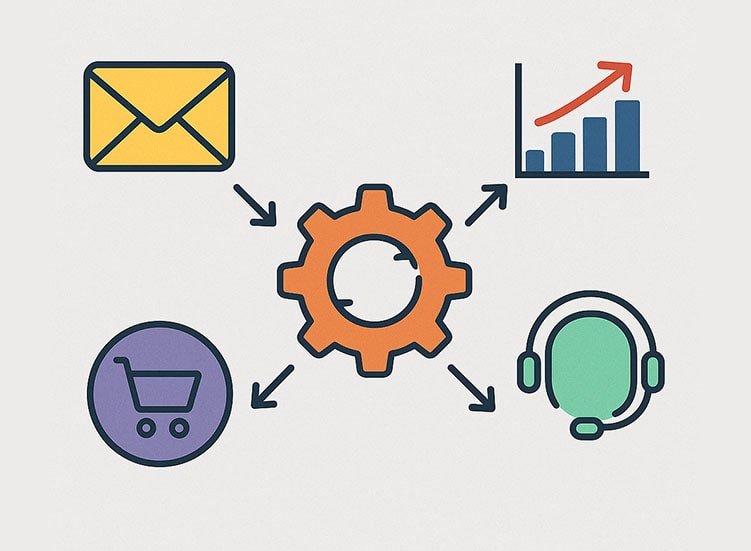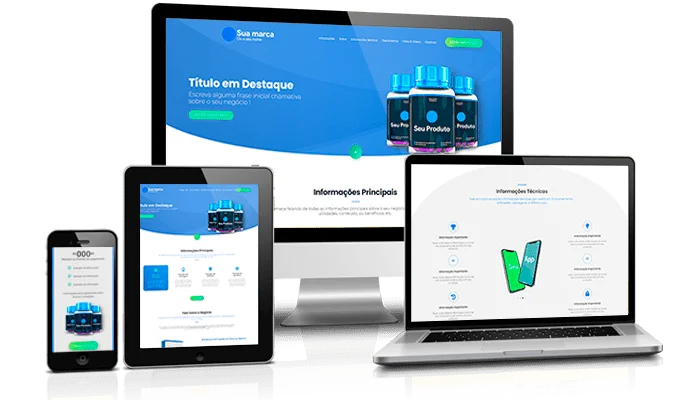If you own a small business, you know how time is scarce. Repetitive routines consume energy and resources and leave little space for what really matters: growing your business. In this scenario, investing in small business automations is not just an option, but a competitive necessity.
This article shows you how you can transform manual tasks into automatic processes, gain productivity and even increase your profits. All this with accessible tools that can be applied to different areas of your business.
What Are Small Business Automations?
Automations are systems that allow repetitive tasks to be executed automatically based on predefined rules. For small businesses, this means automating:
- Email campaigns and marketing workflows
- Inventory management and invoicing
- Customer support through automated responses
- Appointment scheduling and service bookings
- Financial processes like billing and reconciliation
- Post-sale processes, returns, and customer loyalty programs
Real Benefits of Small Business Automations in Daily Operations
1. Free up time for what matters
Automation frees up your team and yourself to focus on strategic work instead of routine tasks.
2. Reduced operational costs
Fewer manual hours means lower spending on staff or freelancers.
3. Increased productivity
Repetitive tasks get done faster and with fewer human errors.
4. Scalability
Your business can grow without needing to proportionally expand your team or infrastructure.
5. Standardization and security
Automated processes follow defined standards and reduce the chance of costly errors.
Where to Apply Small Business Automations Across Your Business Operations

Marketing and Communication
Automated email campaigns (Mailchimp or Brevo)
- Create an account with Mailchimp or Brevo.
- Build your contact list (you can import spreadsheets or capture leads via forms).
- Set up an automation workflow — for example, a welcome sequence for new leads.
- Use built-in templates and personalize them with customer names, products, and offers.
- Launch your workflow and monitor metrics (opens, clicks, conversions).
Scheduled social media posts (Metricool or Buffer)
- Go to Metricool or Buffer.
- Connect your social media profiles (Instagram, Facebook, LinkedIn, X/Twitter).
- Schedule posts with images, captions, and links.
- Use the visual calendar and posting time suggestions.
- Enable performance reports and analyze engagement.
Sales Funnels with RD Station or HubSpot
- Sign up for RD Station or HubSpot.
- Create a landing page to capture interested leads’ emails.
- Set up automation workflows with progressive emails featuring content and offers.
- Use tags to segment leads (hot, cold, customer).
- Enable sales team alerts when a lead is ready to convert.
Customer Support
WhatsApp Chatbots (ManyChat or Zenvia)
- Create an account on ManyChat or Zenvia.
- Connect it to your WhatsApp Business number.
- Set up conversation flows (e.g., welcome messages, appointment booking, FAQs).
- Add quick reply buttons and integrate with your calendar or CRM.
- Publish and monitor the conversations. You can jump in at any point if needed.
Automated Social Media Responses
- Use platforms like Respond.io or Meta Business Suite.
- Enable automated replies for DMs and comments.
- Set trigger keywords (e.g., “price”, “hours”).
- Train the system with your most common FAQs.
- Monitor performance and adjust based on user feedback and common queries.
Sales and CRM
Automatic Lead Capture via Landing Pages
- Use tools like:
✅ LeadPages Easily create professional landing pages, ideal for small businesses looking to generate leads. Build sales pages, forms, and pop-ups without coding.✅ RD Station A good platform for marketing automation and CRM. Great for building sales funnels, email flows, and capturing leads effectively. Perfect for growing SMBs.
✅ HubSpot A global CRM and marketing automation tool with a robust free plan. Automate emails, manage pipelines, and integrate with dozens of apps.
- Create a landing page with an irresistible offer (e.g., free eBook, discount, free consultation).
- Integrate with your CRM to capture leads automatically.
- Enable automatic welcome emails or messages after submission.
Sending Proposals and Email Follow-ups
- Use automation tools like Gmail + Streak or HubSpot.
- Create email templates for proposals to speed up the process.
- Set automated follow-up reminders for unanswered emails.
- Track which proposals were opened and links clicked.
Integration with ERPs and CRMs like Conta Azul or Bling
- Access Bling.
- Register your products, customers, and payment methods.
- Integrate with your website or marketplace to update sales in real time.
- Automatically generate reports with the status of leads, customers, and orders.
Finance and Billing
Automated Invoice and Payment Generation
- On platforms like Conta Azul, Nibo, or Asaas, set up your bank details and payment options.
- Schedule recurring or one-time invoices or payment requests.
- Enable automatic sending via email and WhatsApp.
Bank Integration via Nibo
- Connect your business bank account to Nibo.
- Automatically sync income and expenses.
- Perform daily bank reconciliations effortlessly.
- Generate cash flow reports with a single click.
Real-Time Financial Reporting
- Use ready-made dashboards in Nibo, or TinyERP.
- Track sales by date range, overdue invoices, and net profit.
- Export reports in PDF or Excel format for your accountant.
Logistics and Inventory
Automated Inventory Control with Restock Alerts
- Use inventory systems like Bling or TinyERP.
- Register products and define minimum stock levels.
- Enable email or in-app notifications when stock is low.
Integration with Marketplaces and E-commerce Platforms
- In Bling, connect your store to Mercado Libre, Shopee, Amazon, or your own online store.
- Automatically sync prices, inventory, and order statuses.
- Reduce errors such as overselling or late shipments due to out-of-stock items.
Label Printing and Order Tracking
- Use the logistics modules in Bling.
- Automatically generate shipping labels with order data.
- Batch print labels and automatically send tracking codes to customers.
Recurring Revenue and Post-Sales Automation
Automated Loyalty Programs and Subscription Sales
- Use tools like Yampi, or Hotmart Club to sell recurring products or services.
- Set up monthly, quarterly, or annual plans (e.g., subscription boxes, exclusive classes, VIP access).
- Automate recurring billing with tools like Asaas, Pagar.me, or Stripe.
- Send automatic confirmation emails, renewal reminders, and exclusive bonus content.
Post-Sale Follow-up Workflow
- Create an automated email sequence after purchase using Brevo or Mailchimp:
“Thank you for your purchase.”
“How to use your product/service.”
“Rate your experience.”
“Check out other offers for you.” - Offer a limited-time discount coupon for the next purchase.
- Automate a satisfaction survey using Typeform or Google Forms, integrated with your CRM.
- Segment customers by engagement level and send personalized offers.
Reactivating Inactive Customers
- Segment customers who haven’t purchased in 30, 60, or 90 days.
- Launch reactivation campaigns with emails or messages offering special deals.
- Use triggers like:
“We miss you.”
“Exclusive offer just for you.”
“Last chance to reclaim your benefits.” - Measure the results and optimize your re-engagement cycles based on clicks and conversions.
How to Choose the Right Small Business Automation Tools Without Mistakes
1. Assess your business stage
Startups can benefit from free tools. Growing? It might be time to invest in more robust platforms.
2. Prioritize integrations
Choose tools that can “talk” to each other to reduce manual work and avoid duplicated tasks.
3. Try before you buy
Most platforms offer free plans or trial versions — test them before committing.
4. Consider the learning curve
The more intuitive the tool, the faster and smoother your implementation will be.
Practical Example: How a Small Business Boosted Revenue with Smart Small Business Automations

Meet a young entrepreneur running a small online store that sells handcrafted beauty products.
In the beginning, she managed everything manually: replying to customers on WhatsApp, tracking orders in spreadsheets, and issuing invoices one by one through her bank. Operations were chaotic, and she barely had time to create new products.
Key Challenges
- Frequent stock errors (selling out-of-stock items).
- High cart abandonment with no recovery strategy.
- Wasted time with repetitive tasks like sending emails and generating invoices.
- Slow customer support, especially during weekends.
Solutions Implemented Through Automation
1. Automated Marketing and Sales
- Created a landing page offering 10% off using RD Station to capture leads.
- Set up automated email sequences with welcome messages, product catalogs, and follow-up reminders.
- Implemented a WhatsApp chatbot via ManyChat to handle FAQs and redirect users to the website.
- Recovered abandoned carts using automated reminders sent via email and WhatsApp.
2. Smart Customer Support
- Installed chatbots on the website and WhatsApp with automated responses for common questions.
- Used Meta Business Suite to auto-reply to messages on Instagram and Facebook.
3. Fully Integrated Finances
- Automatically issued invoices and payment slips using Bling.
- Integrated business bank account via Nibo for automatic reconciliation.
- Weekly cash flow reports sent automatically — no spreadsheets needed.
4. Optimized Logistics
- Automated inventory control with low stock alerts.
- Automated label generation and shipment tracking via Melhor Envio.
- Integrated with marketplaces (Shopee, Mercado Livre), keeping everything centralized in one dashboard.
Results after 3 months
- 85% reduction in manual tasks.
- 37% revenue growth driven by improved conversion rates.
- Operational errors dropped from 9 to just 1 per month.
- Faster shipping and higher customer satisfaction.
- Free time for the business owner to focus on product development and strategy.
❓ FAQ – Frequently Asked Questions About Small Business Automation
Start by identifying time-consuming, repetitive tasks such as sending emails, generating invoices, or responding to customer inquiries. Then, choose accessible tools with good integration options, like Mailchimp, Bling, or ManyChat.
Not at all. Many tools offer free or low-cost plans for smaller volumes. Plus, the time and productivity gains usually pay off the investment very quickly.
Tasks like email marketing, inventory tracking, invoice generation, automated social media replies, lead capture, and sales follow-ups are among the easiest to automate.
No. Most modern platforms use intuitive drag-and-drop interfaces, pre-built templates, and step-by-step guides. No advanced technical skills are required.
Yes. Automation boosts efficiency, reduces human error, and helps you seize more sales opportunities with less effort. Sales funnels and automated emails, for example, generate consistent conversions.
Ask yourself: Does it integrate with what you already use (website, CRM, e-commerce)? Does it offer reliable customer support and clear reporting? Can it scale with your business? A free trial is often a good sign.
Conclusion on Small Business Automation
Automation isn’t just for big companies, start today with your small business
Small business automation is no longer a luxury, it’s an essential strategy for those who want to grow without overwhelming their operations. Automating doesn’t mean replacing people; it means allowing your team to focus on what truly drives business growth: quality customer service, better product development, innovation, and strategic decisions.
This guide has shown you how simple tasks, like replying to customers, generating invoices, scheduling social posts, or managing inventory — can be transformed using accessible, intuitive, and even free tools. We’ve also explained how to connect everything through integrated CRMs, ERPs, and sales platforms.
With the right automations, your small business can:
- Save time and increase productivity.
- Reduce errors and rework.
- Boost revenue with less manual effort.
- Gain better financial control and forecasting.
- Offer faster and more efficient customer service.
The best time to automate was yesterday. The second-best time is now.
🔁 Start small, automate one task at a time, and feel the difference.
📣 Did you enjoy this content? Share this article with other entrepreneurs looking to save time, reduce errors, and increase sales with simple, effective automations! 💼✨
Click here for more content on Careers & Entrepreneurship.








